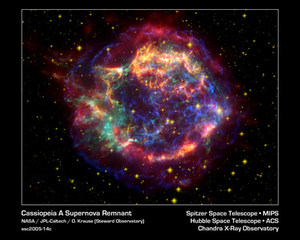
|
| ©NASA/JPL-Caltech/University of Arizona/ Science
|
| A false-color image shows the supernova remnant Cassiopeia A. The picture combines infrared data from the Spitzer Space Telescope (red), visible data from the Hubble Space Telescope (yellow), and x-ray data from the Chandra X-Ray Observatory (green and blue).
|
Astronomers have used an interstellar "mirror" to solve the longstanding mystery over what kind of supernova created Cassiopeia A, one of the brightest radio objects in the sky.
Cass A, as the object is often called, is the expanding remains of a stellar explosion about 9,000 light-years away that is believed to have occurred around A.D. 1680. Until now no one has been able to pinpoint the exact nature of the blast.
So scientists analyzed a "light echo" reflected by interstellar dust to conclude that Cass A arose from a Type IIb supernova - an extremely rare stellar explosion that occurs when a red giant star exhausts the hydrogen in its outer layer, causing the star's helium core to collapse.
"We are able to conclude what type of supernova it was, which is certainly the most important result scientifically," said Oliver Krause, an astronomer at the Max Planck Institute for Astronomy in Heidelberg, Germany.
"It brings together the wealth of observation about the remnant with the explosion."
The results appear in this week's issue of the journal
Science.
Mirror to a Star's SoulIn the past 2,000 years, humans have seen six stars go supernova in the Milky Way. But only one was observed with modern-day astronomical equipment, limiting the amount of data scientists have about the phenomena.
Krause and his coworkers used the fledgling technique of light echoes to rewind time and look at those explosions again. (Related: "Centuries-Old Supernova "Echoes" Detected" [March 20, 2008].)
When stars explode, light erupts in all directions, with only a small fraction directly in Earth's line of sight.
But interstellar dust can act as a mirror, reflecting light that went shooting off in other directions back to Earth hundreds of years later.
Krause's group found infrared signatures from Cass A in an early Spitzer Space Telescope image. The object was one of the first Spitzer captured when it was testing out its optics in 2003.
Krause noticed odd infrared patterns at the edge of image, and follow-up observations found the patterns had changed shape.
Soon the researchers realized they were observing the release of infrared energy from the expanding shockwave of the 300-year-old supernova.
The team got telescope time to determine the spectra of the reflected supernova light and found it matched previously observed Type IIb supernovas.
"The signature of the supernova flash illuminated this dust cloud," Krause said.
"The light is reflected back, and by analyzing this echo you can study the original light outburst. Like with a time machine, we see the 300-year-delayed echo."
Mystery Solved"This is an important paper about a very important object," said Doug Welch, a professor in the McMaster University department of astronomy and physics in Hamilton, Ontario. He was not involved in the new research.
Welch, who helped pioneer the use of light echoes, presented findings at the 2007 meeting of the American Astronomical Society describing the light echoes of Cass A and Tycho Brahe's 1572 supernova.
"What type of supernova caused Cass A has been an enduring mystery for astronomers since it was detected in radio, and [Krause's team has] acquired the key piece of information that allows us to understand it," Welch said.
Using light echoes to study such supernovas is an important new tool, researchers say, because supernovas reveal insights into how particles are dispersed within galaxies and space and how new stars form.
Reader Comments
to our Newsletter